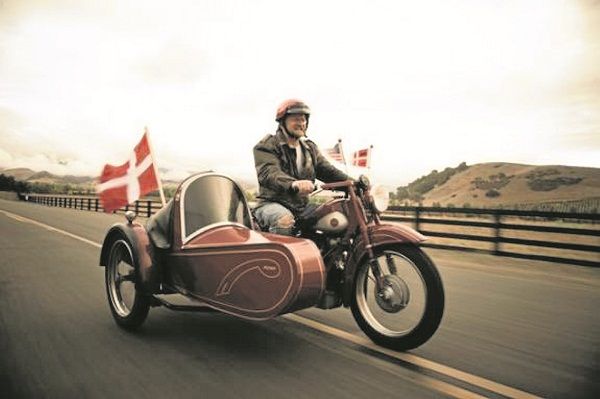Peder Fisker was the founder of Fisker & Nielsen, whose main products were vacuum cleaners. He had no previous interest or experience in the production of motorcycles, and had never even taken a close look until the day he spotted one parked on the street. Fortunately for Danish manufacturing, this one (most probably a Belgian FN) wasn’t much to look at. Its design so offended Fisker’s delicate engineering sensibilities that he decided he had to build a better one.
By 1919 he was producing the Nimbus Model A in Frederiksberg at Peter Bangs Vej 30. The motorcycle became popularly known as ‘The Stovepipe’ because of its huge frame backbone, which doubled as a gas tank.
In 1924 the Model B came out with an improved front fork, but elements of both models were markedly different from other motorcycles of the time. In addition to the frame gas tank, the bike used rear suspension, a drive shaft instead of unreliable chains, and one of the first ever kick-start systems designed for a motorcycle, which operated via the camshaft. The 746cc engine used a four-cylinder inline construction to maintain cruising speeds of 70 kilometres per hour (km/h) and a top speed of about 100 km/h. The gearbox had three speeds and gear changes took place by hand.
Expensive rides
The Models A and B did well in long distance races by virtue of their reliability and gained a lot of publicity; however, each cost about as much as a Ford Model T. In its first incarnation, the Nimbus never became a big seller and only 1,252 were produced before factory problems and the introduction of sales tax on motor vehicles halted manufacturing altogether. This was a machine originally conceived in the small, flat nation of Denmark back in 1915, when roads were unpaved and motor vehicles still made way for horse-drawn wagons.
Luckily PA Fisker’s son Anders followed in his footsteps with more creative construction ideas. Anders had received his first Nimbus in 1926 and was sorry to see them go out of production in 1927. As a passionate motorcyclist and civil engineer, he was able to convince his father and the company board members to bring his own Nimbus design into production in 1932. Father and son developed the prototype together, resulting in the Nimbus Model C, which was manufactured until 1959.
The 1934 Model C was the first production motorcycle to feature a telescopic front fork, beating the BMW R12 by a year. Currently the most common fork commercially available, the telescopic fork combines suspension with good manoeuvrability. But these early models didn’t have the benefit of hydraulic damping, leaving the front end bouncing down the road until the weight of gravity eventually smoothed the way.
From Horsens to Solvang
Nimbus used a number of different 746cc four-cylinder engines over the years, including side-valve, inlet-over-exhaust and overhead-cam versions, either water or air-cooled. The hum of the engine and speed of the motorcycle resulted in the nickname ‘Bumblebee’, which PA Fisker infinitely preferred to the ‘Stovepipe’. The basic design of the Bumblebee was also unique. The entire frame was built of flat steel bar stock and steel plate, riveted together, rather than welded. Anders’ idea was that if the bike was damaged in an accident, individual elements could be replaced rather than fixed.
In the late 1930s, the Nimbus became the best-selling motorcycle in Denmark. Approximately 1,000 bikes were built per year – around 20 percent for the Danish military, while another large chunk was purchased by the postal service. Out of a total production of around 12,000, it is estimated that around 4,000 are still registered and running in Denmark alone.
In addition to the Nimbus Museum in Horsens, the motorcycles also feature in collections in other countries, including one in Solvang, California. Nearby in Seal Beach, California, the Nimbus Club USA organises a number of other events, including charity rides and rallies.
“I founded the Nimbus Motorcycle Club of America more as a joke, back about 15 years ago,” explained Kaj Pedersen, who has lived in the US for several decades and is the association’s president for life. “An old school mate of mine from Thyborn moved out to California about a year after I was transferred through work, and since he also had a Nimbus, I figured why not start the world’s smallest motorcycle club, two members strong. But since then the club has grown to about 85-90 members with about 100 Nimbus motorcycles.”
Reliability above all
Club members range from designers to professors and mechanics. One member in North Carolina owns Steve McQueen’s famous 1939 Nimbus with a sidecar. “We ride a type of bike that is rarely seen – most bikes this age are either sitting in a display window or a museum somewhere. We get a lot of respect for maintaining and riding these bikes, wherever we go,” explained Pedersen.
All the Nimbus models are known as extremely reliable workhorses that continue to have available spare parts. In 2009 two Norwegians set out on a journey around the world on a Nimbus with a sidecar, a test of their mettle and the bike’s endurance. They blog continuously about their trip at www.kccd.no.
At Nimbus Club USA the group ride long distances for a variety of charity functions and events. “Most people find it hard to believe that anyone would actually ride hundreds of miles on a 60-70 year old Nimbus motorcycle,” said Pedersen. “Another common statement from onlookers is: ‘I have never seen or heard of a Nimbus, and here are five to six of them.’ Yeah, we do get plenty of looks wherever we go, and most of them positive.”













